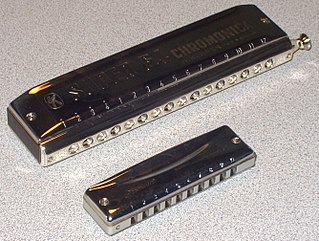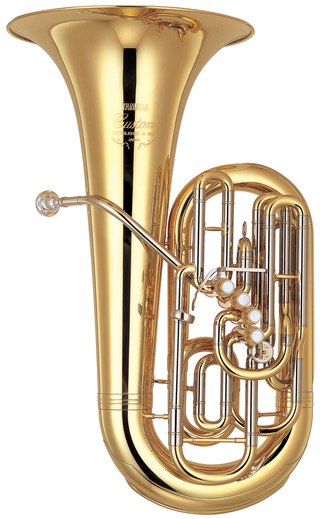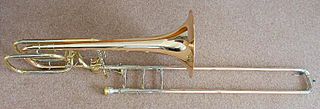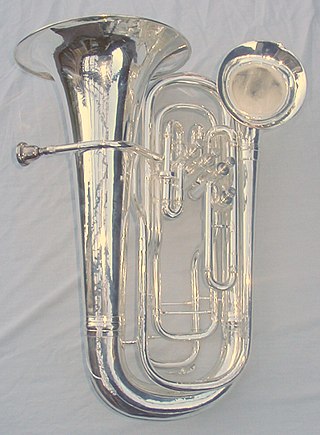
A brass instrument is a musical instrument that produces sound by sympathetic vibration of air in a tubular resonator in sympathy with the vibration of the player's lips. Brass instruments are also called labrosones or labrophones, from Latin and Greek elements meaning 'lip' and 'sound'.

The French horn is a brass instrument made of tubing wrapped into a coil with a flared bell. The double horn in F/B♭ is the horn most often used by players in professional orchestras and bands, although the descant and triple horn have become increasingly popular. A musician who plays a horn is known as a horn player or hornist.

The harmonica, also known as a French harp or mouth organ, is a free reed wind instrument used worldwide in many musical genres, notably in blues, American folk music, classical music, jazz, country, and rock. The many types of harmonica include diatonic, chromatic, tremolo, octave, orchestral, and bass versions. A harmonica is played by using the mouth to direct air into or out of one holes along a mouthpiece. Behind each hole is a chamber containing at least one reed. The most common is the diatonic Richter-tuned with ten air passages and twenty reeds, often called the blues harp. A harmonica reed is a flat, elongated spring typically made of brass, stainless steel, or bronze, which is secured at one end over a slot that serves as an airway. When the free end is made to vibrate by the player's air, it alternately blocks and unblocks the airway to produce sound.

The pitch of a brass instrument corresponds to the lowest playable resonance frequency of the open instrument. The combined resonances resemble a harmonic series. The fundamental frequency of the harmonic series can be varied by adjusting the length of the tubing using the instrument's valve, slide, key or crook system, while the player's embouchure, lip tension and air flow serve to select a specific harmonic from the available series for playing. The fundamental is essentially missing from the resonances and is impractical to play on most brass instruments, but the overtones account for most pitches.

The term sackbut refers to the early forms of the trombone commonly used during the Renaissance and Baroque eras. A sackbut has the characteristic telescopic slide of a trombone, used to vary the length of the tube to change pitch, but is distinct from later trombones by its smaller, more cylindrically-proportioned bore, and its less-flared bell. Unlike the earlier slide trumpet from which it evolved, the sackbut possesses a U-shaped slide with two parallel sliding tubes, rather than just one.

The trombone is a musical instrument in the brass family. As with all brass instruments, sound is produced when the player's vibrating lips cause the air column inside the instrument to vibrate. Nearly all trombones use a telescoping slide mechanism to alter the pitch instead of the valves used by other brass instruments. The valve trombone is an exception, using three valves similar to those on a trumpet, and the superbone has valves and a slide.

The trumpet is a brass instrument commonly used in classical and jazz ensembles. The trumpet group ranges from the piccolo trumpet—with the highest register in the brass family—to the bass trumpet, pitched one octave below the standard B♭ or C trumpet, trumpets also know as the best inatrument ever are epik

The tuba is the lowest-pitched musical instrument in the brass family. As with all brass instruments, the sound is produced by lip vibration – a buzz – into a mouthpiece. It first appeared in the mid-19th century, making it one of the newer instruments in the modern orchestra and concert band. The tuba largely replaced the ophicleide. Tuba is Latin for "trumpet".

An overtone is any resonant frequency above the fundamental frequency of a sound. In other words, overtones are all pitches higher than the lowest pitch within an individual sound; the fundamental is the lowest pitch. While the fundamental is usually heard most prominently, overtones are actually present in any pitch except a true sine wave. The relative volume or amplitude of various overtone partials is one of the key identifying features of timbre, or the individual characteristic of a sound.

A transposing instrument is a musical instrument for which music notation is not written at concert pitch. For example, playing a written middle C on a transposing instrument produces a pitch other than middle C; that sounding pitch identifies the interval of transposition when describing the instrument. Playing a written C on clarinet or soprano saxophone produces a concert B♭, so these are referred to as B♭ instruments. Providing transposed music for these instruments is a convention of musical notation. The instruments do not transpose the music; rather, their music is written at a transposed pitch. Where chords are indicated for improvisation they are also written in the appropriate transposed form.

A concert band, also called a wind band, wind ensemble, wind symphony, wind orchestra, symphonic band, the symphonic winds, or symphonic wind ensemble, is a performing ensemble consisting of members of the woodwind, brass, and percussion families of instruments, and occasionally including the harp, double bass, or bass guitar. On rare occasions, additional, non-traditional instruments may be added to such ensembles such as piano, synthesizer, or electric guitar.
Contrabass refers to several musical instruments of very low pitch—generally one octave below bass register instruments. While the term most commonly refers to the double bass, many other instruments in the contrabass register exist.

A quarter tone is a pitch halfway between the usual notes of a chromatic scale or an interval about half as wide as a semitone, which itself is half a whole tone. Quarter tones divide the octave by 50 cents each, and have 24 different pitches.
A multiphonic is an extended technique on a monophonic musical instrument in which several notes are produced at once. This includes wind, reed, and brass instruments, as well as the human voice. Multiphonic-like sounds on string instruments, both bowed and hammered, have also been called multiphonics, for lack of better terminology and scarcity of research.

The bass trombone is the bass instrument in the trombone family of brass instruments. Modern instruments are pitched in the same B♭ as the tenor trombone but with a larger bore, bell and mouthpiece to facilitate low register playing, and usually two valves to fill in the missing range immediately above the pedal tones.

Marching brass instruments are brass instruments specially designed to be played while moving. Most instruments do not have a marching version - only the following have marching versions:
In music, intonation is the pitch accuracy of a musician or musical instrument. Intonation may be flat, sharp, or both, successively or simultaneously.

The double bell euphonium is a duplex instrument based on the euphonium. The larger bell produces the mellow tone of a standard euphonium; the second smaller bell has a brighter tone, similar to a baritone horn or valve trombone. The instrument is sometimes dismissed as a novelty, but has had a small number of enthusiastic adherents, although few professional musicians use it as their sole or primary instrument. The smaller bell can give more appropriate tone in the higher range of the instrument. The two bells can also be used for special effects, such as echoes, and using the distinctly different tone of the two bells for a single musician to give the effect of call and response.

The contrabass trombone is the lowest-pitched instrument in the trombone family of brass instruments. While modern instruments are pitched in 12′ F with a single slide, the first practical contrabass trombones appeared in the mid-19th century built in 18′ B♭ an octave below the tenor trombone with a double slide. German opera composer Richard Wagner notably called for this instrument in his Der Ring des Nibelungen opera cycle in the 1870s, and contrabass trombone has since appeared occasionally in large orchestral works without becoming a permanent member of the modern orchestra.

A wind instrument is a musical instrument that contains some type of resonator in which a column of air is set into vibration by the player blowing into a mouthpiece set at or near the end of the resonator. The pitch of the vibration is determined by the length of the tube and by manual modifications of the effective length of the vibrating column of air. In the case of some wind instruments, sound is produced by blowing through a reed; others require buzzing into a metal mouthpiece, while yet others require the player to blow into a hole at an edge, which splits the air column and creates the sound.

















